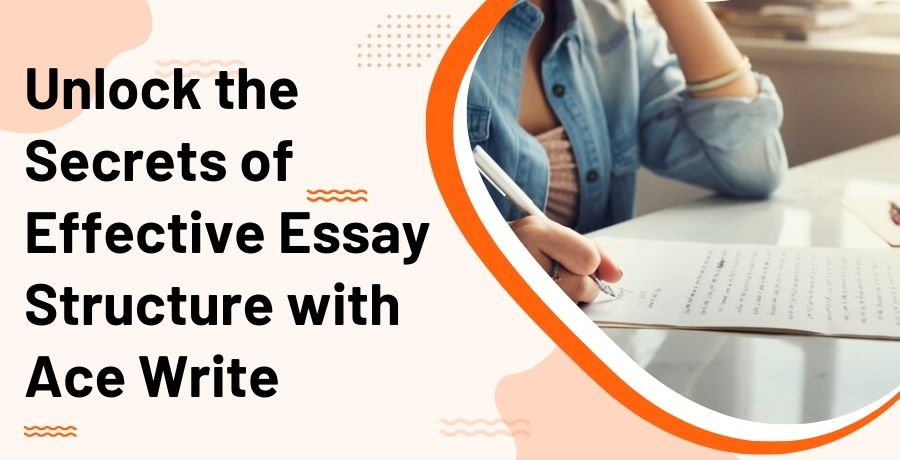What Is The Format Of Essay Writing?

Essay writing is a fundamental skill that students and professionals alike must master. Central to effective essay writing is understanding the proper format Of the Essay. In this comprehensive guide brought to you by Ace Write, we’ll explore the format of the essay, providing you with the knowledge and tools to craft compelling and well-structured essays. We’ll cover everything from essay structure guidelines to formatting standards to ensure you ace your next essay assignment.
Understanding Essay Format Before diving into the specifics of essay formats, it’s essential to grasp the principles underpinning effective writing. Essays are structured writing pieces that present arguments or ideas on a particular topic. They typically consist of an introduction, body paragraphs, and a conclusion. The format of an essay provides a framework for organizing your thoughts and presenting your arguments clearly and logically.
Critical Elements of Essay Format
Introduction The introduction sets the stage for your essay and introduces the main topic or argument. It should grab the reader’s attention, provide necessary background information, and end with a clear thesis statement outlining the main points you will discuss.
Body Paragraphs The essay’s body contains the main arguments or points supporting your thesis. Each body paragraph should focus on your argument’s single idea or aspect and include supporting evidence, examples, or analysis. Ensure that your body paragraphs flow logically from one to the next, building a coherent and persuasive argument.
Conclusion The conclusion summarizes the main points of your essay and reinforces your thesis statement. It should provide a sense of closure to your essay while leaving a lasting impression on the reader. Avoid introducing new information in the conclusion; instead, focus on synthesizing your ideas and leaving the reader with a thought-provoking insight or call to action.
Essay Organization Guideline
Hook The introduction begins with a hook, a compelling statement or question designed to capture the reader’s attention and draw them into the essay. The hook should be relevant to the topic and set the tone for the rest of the essay.
Background Information Following the hook, the introduction provides background information on the topic. This may include definitions of key terms, relevant historical context, or an overview of the discussed issue. The background information helps to contextualize the subject for the reader and provides a foundation for the thesis statement.
Thesis Statement The introduction concludes with a clear and concise thesis statement that outlines the central argument or purpose of the essay. The thesis statement presents the central idea that the essay will explore and defend, serving as a roadmap for the reader to follow.
Body Paragraphs
Topic Sentence (Body Paragraph 1) Each body paragraph begins with a topic sentence that introduces the main point or argument of that paragraph. The topic sentence guides the reader, indicating what aspect of the topic will be discussed in the section.
Supporting Evidence After the topic sentence, the body paragraph provides supporting evidence to substantiate the main point or argument. This may include facts, statistics, examples, quotations, or anecdotes that support the topic sentence and contribute to the essay’s overall argument.
Topic Sentence (Body Paragraph 2) The next body paragraph follows the same structure, with a topic sentence introducing a new central point or argument. Each body paragraph should focus on a distinct idea or aspect of the topic, providing specific evidence to support it.
Supporting Evidence Similar to the first body paragraph, this paragraph provides supporting evidence to bolster the main point or argument introduced in the topic sentence.
Conclusion
Restate Thesis The conclusion begins by restating the thesis statement in different words. This reaffirms the essay’s central argument and reminds the reader of its significance.
Summarize Main Points Following the restatement of the thesis, the conclusion summarizes the main points or arguments presented in the body paragraphs. This reinforces the critical ideas of the essay and demonstrates how they collectively support the thesis.
Closing Statement Finally, the conclusion concludes with a closing statement that leaves a lasting impression on the reader. This may include a thought-provoking insight, a call to action, or a further research or reflection suggestion. The closing statement should provide a sense of closure and leave the reader with something to ponder.
Proper Essay Layout In addition to structuring your essay effectively, it’s essential to pay attention to the layout and formatting
- Font and Font Size Use a readable font such as Times New Roman or Arial, and set the font size to 12 points.
- Margins Use standard 1-inch margins on all sides of the page.
- Line Spacing Double-space your essay to improve readability and leave space for comments or corrections.
- Title Page (if required) Include a title page with your name, instructor’s name, course title, and date.
- Page Numbers Number your pages consecutively in the upper righthand corner, starting with the first page of text.
Essay Writing Format Following these formatting standards will ensure that your essay looks polished and professional
- Alignment Align your text to the left and use ragged right margins.
- Indentation Indent the first line of each paragraph by 0.5 inches or use the tab key.
- Headings and Subheadings Use headings and subheadings to organize your essay and guide the reader through your arguments.
- Citations and References If you’re using outside sources, follow the appropriate citation style (e.g., MLA, APA, Chicago) and include a reference list or bibliography at the end of your essay.
Overview
Mastering the essay writing format is essential for effectively communicating your ideas and arguments. By understanding the key elements of essay structure, organizing your thoughts logically, and following proper formatting guidelines.
You can craft compelling and impactful essays that engage and persuade your audience. With the support and expertise of Ace Write, you can confidently tackle any essay assignment and achieve academic and professional success.
